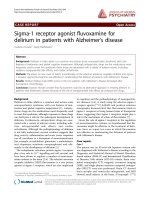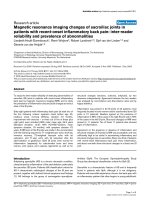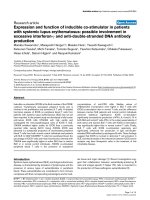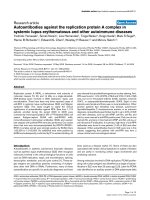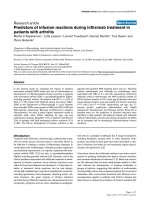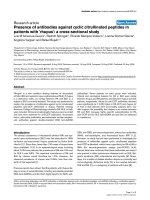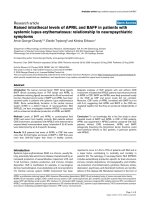Báo cáo y học: "How can the response to volume expansion in patients with spontaneous respiratory movements be predicted" ppsx
Bạn đang xem bản rút gọn của tài liệu. Xem và tải ngay bản đầy đủ của tài liệu tại đây (336 KB, 7 trang )
Open Access
Available online />Page 1 of 7
(page number not for citation purposes)
Vol 10 No 4
Research
How can the response to volume expansion in patients with
spontaneous respiratory movements be predicted?
Sarah Heenen, Daniel De Backer and Jean-Louis Vincent
Department of Intensive Care, Erasme University Hospital, Free University of Brussels, Route de Lennik, 808, B-1070 Brussels, Belgium
Corresponding author: Daniel De Backer,
Received: 11 Jan 2006 Revisions requested: 31 Jan 2006 Revisions received: 8 Jun 2006 Accepted: 26 Jun 2006 Published: 17 Jul 2006
Critical Care 2006, 10:R102 (doi:10.1186/cc4970)
This article is online at: />© 2006 Heenen et al.; licensee BioMed Central Ltd.
This is an open access article distributed under the terms of the Creative Commons Attribution License ( />),
which permits unrestricted use, distribution, and reproduction in any medium, provided the original work is properly cited.
Abstract
Introduction The aim of the study was to evaluate the ability of
different static and dynamic measurements of preload to predict
fluid responsiveness in patients with spontaneous respiratory
movements.
Methods The subjects were 21 critically ill patients with
spontaneous breathing movements receiving mechanical
ventilation with pressure support mode (n = 9) or breathing
through a face mask (n = 12), and who required a fluid
challenge. Complete hemodynamic measurements, including
pulmonary artery occluded pressure (PAOP), right atrial
pressure (RAP), pulse pressure variation (∆PP) and inspiratory
variation in RAP were obtained before and after fluid challenge.
Fluid challenge consisted of boluses of either crystalloid or
colloid until cardiac output reached a plateau. Receiver
operating characteristics (ROC) curve analysis was used to
evaluate the predictive value of the indices to the response to
fluids, as defined by an increase in cardiac index of 15% or
more.
Results Cardiac index increased from 3.0 (2.3 to 3.5) to 3.5
(3.0 to 3.9) l minute
-1
m
-2
(medians and 25th and 75th centiles),
p < 0.05. At baseline, ∆PP varied between 0% and 49%. There
were no significant differences in ∆PP, PAOP, RAP and
inspiratory variation in RAP between fluid responders and non-
responders. Fluid responsiveness was predicted better with
static indices (ROC curve area ± SD: 0.73 ± 0.13 for PAOP, p
< 0.05 vs ∆PP and 0.69 ± 0.12 for RAP, p = 0.054 compared
with ∆PP) than with dynamic indices of preload (0.40 ± 0.13 for
∆PP and 0.53 ± 0.13 for inspiratory changes in RAP, p not
significant compared with ∆PP).
Conclusion In patients with spontaneous respiratory
movements, ∆PP and inspiratory changes in RAP failed to
predict the response to volume expansion.
Introduction
Fluid challenge is commonly performed in critically ill patients
but the response is quite variable [1]. Inappropriate fluid
administration can result in interstitial edema, which may have
harmful consequences, especially in patients with respiratory
failure. Measurements of cardiovascular pressures or volumes
do not reliably predict fluid responsiveness [1], because a
given value may be associated with preload dependence as
well as preload independence.
Recently, dynamic evaluation of preload indexes has been
introduced, on the basis of the observation that cyclic changes
in intrathoracic pressure induced by mechanical ventilation
can result in concurrent changes in stroke volume in preload-
dependent, but not in preload-independent, patients. These
dynamic indices of preload can better predict the individual
response to fluid loading than static indices [1-5].
However, all these studies have been performed in patients
receiving mechanical ventilation, well sedated and even para-
lyzed to avoid any spontaneous respiratory movements. But
spontaneous respiratory movements, inspiratory as well as
expiratory, can also influence venous flow, preload, and after-
load [6,7]. Rooke and colleagues [8] reported in seven awake
subjects that systolic pressure variation did not change in
response to blood withdrawal or volume infusion, but cardiac
output was not measured in these patients. Hence, cardiac
output may have been maintained in these healthy subjects, as
a result of an adrenergic reaction. In addition, the impact of
respiratory movements in patients treated with mechanical
CI = cardiac index; ∆CI = change in cardiac index; ∆PP = pulse pressure variation; PAOP = pulmonary artery occluded pressure; RAP = right atrial
pressure; RAP
ee
= RAP at end-expiration; RAP
ei
= RAP at end-inspiration; ROC = receiver operating characteristics; VE = volume expansion.
Critical Care Vol 10 No 4 Heenen et al.
Page 2 of 7
(page number not for citation purposes)
ventilation may have more limited impact, as inspiration is still
associated with an increase in pleural pressure.
We therefore designed this study to assess the value of sev-
eral dynamic and static indices of preload as predictors of fluid
responsiveness in spontaneously breathing patients, receiving
mechanical ventilation in pressure support mode or breathing
through a face mask.
Materials and methods
Ethical considerations
This study was approved by the local Ethical Committee, and
informed consent was obtained from the patients or their rela-
tives.
Patients
This prospective study included 21 patients over a six month
period. Inclusion criteria consisted of the need for fluid loading
(for arterial hypotension, tachycardia, or oliguria) in a patient
equipped with a central venous catheter and an arterial cathe-
ter, in whom cardiac output was determined by the thermodi-
lution technique either with a pulmonary artery catheter
(Vigilance; Edwards Lifesciences, Irvine, CA, USA) or by a
modified arterial catheter (PiCCO; Pulsion, Munich, Ger-
many). For inclusion, each patient had to show spontaneous
breathing movements. Exclusion criteria were the following:
age less than 18 years, pregnancy, and any significant cardiac
arrhythmia. Fourteen patients were treated with vasoactive
agents; no change in vasoactive treatment was allowed during
the study period.
Methods
Arterial pressure was measured with either radial or femoral
arterial catheters. Cardiac output was measured with a pulmo-
nary artery catheter (Swan–Ganz catheter, Vigilance 7.5
French; Edwards Lifesciences) in 20 patients and by transpul-
monary thermodilution (PiCCO, PVPK, 5 French; Pulsion) in
one patient. After calibration, all pressures were recorded on
a computer system. We looked carefully at patient respiratory
efforts and manually noted each breath initiation. Right atrial
pressure was measured both at end-expiration (RAP
ee
) and
end-inspiration (RAP
ei
). When available, pulmonary arterial
pressures and pulmonary artery occluded pressure (PAOP)
were also measured at end-expiration. The arterial pressure
waveforms were measured on the computer system, and vari-
ation in pulse pressure (∆PP) was calculated. The respiratory
variation in RAP was calculated as RAP
ee
- RAP
ei
.
A complete set of hemodynamic measurements as well as
blood sampling for arterial and mixed venous blood gases
were obtained at baseline and before each volume expansion
(VE). VE consisted of 500 ml of synthetic colloid (Voluven
®
,
hydroxyethylstarch 6%; Fresenius, Bad Homburg, Germany)
or 1,000 ml of crystalloid (Hartmann solution; Baxter, Less-
ines, Belgium) infused over 30 minutes. Hemodynamic meas-
urements were obtained after each 250 ml aliquot. The VE
was interrupted when the cardiac output did not increase fur-
ther and PAOP or RAP increased by more than 3 mmHg. At
the end of VE, another complete set of hemodynamic meas-
urements, including venous and arterial blood gases, was
obtained. A rise of 15% or more in cardiac output between
baseline and final measurements defined the responders.
Statistics
As data were not normally distributed, non-parametric statisti-
cal tests were used; data are presented as medians, with 25th
and 75th centiles in parentheses. The effects of VE on the
hemodynamic variables were analyzed with the Wilcoxon rank
test. Baseline values for responders and non-responders were
compared by using the Mann–Whitney test. Spearman's cor-
relations were used to analyze the relationship between base-
line measurements and changes in cardiac index (∆CI).
Receiver operating characteristics (ROC) curves were used to
evaluate the predictive value of the various indices on fluid
responsiveness. ROC curve area are presented as area ± SD.
A p value less than 0.05 was considered significant.
Table 1
Characteristics of general population
Parameter Value
Age (years) 74 (61–78)
Weight 80 (65–90)
Survivors, n (%) 17 (80)
Surgical, n (%) 15 (71)
Heart surgery 11
AAA 4
Medical 6
Sepsis 4
Intestinal bleeding 2
Vasoactive drugs 14
Dobutamine, n; dose, µg kg
-1
minute
-1
8; 5 (3–8)
Dopamine 6; 15 (14–20)
Norepinephrine 4; 0.4 (0.3–0.6)
Sodium nitroprusside 2; 20–120
Mechanical ventilation, n (%) 9 (43)
Respiratory rate, minute
-1
24 (19–27)
Cardiac beat per breath, n 4.2 (3.5–5.4)
PEEP (n = 9), cmH
2
O 5 (5–5)
Pressure support level (n = 9), cmH
2
O 22 (12–25)
FiO
2
0.5 (0.4–0.5)
Ranges in parentheses are 25th to 75th centiles. AAA, abdominal
aortic aneurysm; FiO
2
, fraction of inspired oxygen; PEEP, positive
end-expiratory pressure.
Available online />Page 3 of 7
(page number not for citation purposes)
Results
Patient characteristics are shown in Table 1. Nine patients
were ventilated in pressure support mode and 12 were breath-
ing spontaneously by means of a face mask. Four of the 21
patients received colloids (500 (437 to 500) ml) and 17
received crystalloids (1,000 (750 to 1,000) ml). Fluid chal-
lenge was stopped either because cardiac output failed to
increase initially (n = 2) or because it reached a plateau (n =
19), in the presence of an increase in RAP or PAOP by at least
3 mmHg. Fluid infusion was stopped after one aliquot in two
patients, two aliquots in six, three aliquots in three, and four
aliquots in ten. None of the patients required more than four
aliquots. Seventeen patients survived. The effects of VE are
shown in Table 2. Cardiac index (CI) increased from 3.0 (2.3
to 3.5) to 3.5 (3.0 to 3.9) l minute
-1
m
-2
(p < 0.05), but it
increased by more than 15% in only nine patients.
At baseline, ∆PP varied between 0 and 49%. There were no
significant differences in ∆PP, PAOP at end-expiration, RAP
ee
and inspiratory variation in RAP between responders and non-
responders (Table 3).
No significant relationship was found between the change in
CI (∆CI) during VE and ∆PP baseline for the entire group or for
the subgroups (mechanical ventilation and spontaneous
breathing; Figure 1). The relationships between PAOP at
baseline and ∆CI (Figure 2) and RAP
ee
at baseline and ∆CI
(Figure 3) were not significant (p = 0.08 for each). There was
no relationship between the inspiratory variation in RAP at
baseline and ∆CI (Figure 4).
The predictive value of the various indices on fluid responsive-
ness was compared (Figure 5). The ROC curve area was
larger for static indices (0.73 ± 0.13 for PAOP, p < 0.05 com-
pared with ∆PP; and 0.69 ± 0.12 for RAPee, p = 0.054 com-
pared with ∆PP) than for dynamic indices of preload (0.40 ±
0.13 for ∆PP, and 0.53 ± 0.13 for inspiratory variation in RAP;
p not significant compared with ∆PP). The likelihood of a
response to fluids was highest at low values of RAP (Figure 6)
and PAOP (data not shown), and decreased progressively
when RAP and PAOP were higher.
Table 2
Evolution of the hemodynamic variables after VE
Parameter Value
Baseline After VE
Temperature, °C 37.1 (36.7–37.9) 37.0 (36.7–37.7)
Cardiac frequency, minute
-1
94 (83–105) 97 (82–111)
Mean arterial pressure, mmHg 73 (67–81) 75 (69–83)
∆PP, % 11 (7–18) 9 (4–16)
Mean PAP, mmHg 20 (14–25) 22 (18–29)
PAOP
ee
, mmHg 13 (9–15) 15 (10–19)
a
RAP
ee
, mmHg 9 (5–12) 10 (7–13)
b
Inspiratory ∆RAP, mmHg -3 (-5 to -1) -2 (-4 to 0)
Cardiac index, l minute
-1
m
-2
3.0 (2.3–3.5) 3.5 (3.1–3.9)
a
Oxygen delivery, ml minute
-1
m
-2
402 (353–432) 434 (379–518)
b
Oxygen consumption, ml
minute
-1
m
-2
138 (126–153) 145 (92–156)
Arterial pH 7.42 (7.38–7.45) 7.42 (7.39–7.48)
PaCO
2
38 (34–39) 38 (37–39)
PaO
2
99 (86–117) 96 (85–114)
SaO
2
99 (98–99) 99 (97–100)
SvO
2
67 (60–72) 71 (63–74)
Hemoglobin, g/dl 9.1 (8.9–12.0) 9.0 (8.1–11.2)
b
Lactate, mEq/l 1.4 (1.2–1.9) 1.2 (1.0–1.5)
b
Ranges in parentheses are 25th to 75th centiles. ∆PP, pulse
pressure variation; ∆RAP, variation in right atrial pressure; PAOP
ee
,
pulmonary arterial occluded pressure at end-expiration; PAP,
pulmonary arterial pressure; RAP
ee
, right atrial pressure at end-
expiration; PaCO
2
, arterial partial pressure of CO
2
; PaO
2
, arterial
partial pressure of oxygen; SaO
2
, arterial oxygen saturation; SvO
2
,
mixed venous oxygen saturation; VE, volume expansion.
a
p < 0.01,
and
b
p < 0.05 compared with baseline.
Table 3
Baseline values in responders versus non-responders
Parameter Value
Non-responders (n = 12) Responders (n = 9)
Temperature, °C 36.9 (36.6–37.9) 37.2 (36.9–38.0)
Heart rate, minute
-1
96 (79–105) 93 (88–110)
Mean arterial pressure,
mmHg
74 (67–81) 70 (68–79)
∆PP, % 15 (6–19) 9 (5–16)
Mean PAP, mmHg 21 (18–25) 17 (15–26)
PAOP
ee
, mmHg 14 (11–16) 11 (5–15)
RAP
ee
, mmHg 11 (7–15) 5 (5–10)
Inspiratory ∆RAP, mmHg -3 (-5 to -1) -4 (-5 to -2)
Cardiac index, l minute
-1
m
-2
3.2 (2.7–3.5) 2.7 (2.3–3.4)
Arterial pH 7.39 (7.37–7.45) 7.44 (7.42–7.47)
a
PaCO
2
38 (36–40) 36 (31–39)
PaO
2
97 (85–113) 108 (89–125)
SaO
2
99 (97–99) 99 (98–99)
SvO
2
67 (57–72) 67 (64–74)
Hemoglobin, g/dl 9.0 (8.8–11.9) 10.4 (8.7–12.5)
Lactate, mEq/l 1.6 (1.4–2.4) 1.3 (1.1–1.4)
∆PP, pulse pressure variation; ∆RAP, variation in right atrial pressure;
PaCO
2
, arterial partial pressure of CO
2
; PaO
2
, arterial partial pressure
of oxygen; PAOP
ee
, pulmonary arterial occluded pressure at end-
expiration; PAP, pulmonary arterial pressure; RAP
ee
, right atrial
pressure at end-expiration; SaO
2
, arterial oxygen saturation; SvO
2
,
mixed venous oxygen saturation. Ranges in parentheses are 25th to
75th centiles.
a
p < 0.05 between the two groups.
Critical Care Vol 10 No 4 Heenen et al.
Page 4 of 7
(page number not for citation purposes)
Several subgroup analyses were conducted to provide a bet-
ter definition of the potential factors influencing ∆PP and
inspiratory variation in RAP. No patient had evidence of right
ventricular dysfunction, either before or after fluid challenge.
We noticed active expiratory efforts in four patients, but
excluding these patients did not alter the results (data not
shown). The ROC curve area of ∆PP was 0.64 ± 0.26 in
patients receiving mechanical ventilation, and 0.29 ± 0.17 in
patients breathing through a face mask (p = 0.25). For inspir-
atory variation in RAP, only three patients had no decrease in
CVP during inspiration, and one of these responded to fluid
challenge (negative predictive value of 66%). In comparison, 8
of the 18 patients with a 1 mmHg inspiratory decrease in RAP
responded to fluids (the positive predictive value was 44%).
Four patients presented respiratory efforts insufficient to gen-
erate an inspiratory decrease in PAOP of more than 2 mmHg,
and excluding these patients from the analysis did not alter our
results (data not shown).
Discussion
Important questions are the following. Which indices can be
used to predict fluid responsiveness in patients with respira-
tory movements [9]? In particular, can dynamic indexes of
preload be useful in this context? The data reported so far
have been obtained for patients who were deeply sedated and
even paralyzed [2,10], a situation that physicians prefer to
avoid whenever possible [11]. Our results show that ∆PP can-
not predict fluid responsiveness reliably in patients who either
trigger the respirator or breathe spontaneously. Furthermore,
its predictive value is inferior to that of static measurements of
cardiac filling pressures.
It has indeed been proposed that ∆PP (and other indices of
ventilation-induced stroke volume variations) may not apply in
patients breathing spontaneously [6,7], but this has never
been shown. Pinsky and colleagues [12] reported that spon-
taneous respiratory efforts in dogs increased transmural right
atrial pressure and right ventricular stroke volume, whereas
positive pressure ventilation induced inverse changes, thus
suggesting that breathing movements and positive pressure
ventilation may both be used to evaluate heart-lung interac-
Figure 1
Relation between the ∆PP and the maximal ∆CI after volume expansionRelation between the ∆PP and the maximal ∆CI after volume expansion.
This relationship was not significant (R
2
= 0.02, p = 0.94). Diamonds,
patients breathing through a face mask; squares, patients receiving
pressure support ventilation. ∆CI, change in cardiac index; ∆PP, pulse
pressure variation.
Figure 2
Relation between PAOP at baseline and maximal ∆CI during volume expansionRelation between PAOP at baseline and maximal ∆CI during volume
expansion. ∆CI, change in cardiac index; PAOP, pulmonary artery
occluded pressure.
Figure 3
Relation between RAP at baseline and maximal ∆CI during volume expansionRelation between RAP at baseline and maximal ∆CI during volume
expansion. ∆CI, change in cardiac index; RAP, right atrial pressure.
Available online />Page 5 of 7
(page number not for citation purposes)
tions and to predict fluid responsiveness. However, our study
indicates that the capacity of ∆PP to predict changes in car-
diac index during fluid challenge is inaccurate in the presence
of spontaneous respiratory movements.
Spontaneous respiratory movements can affect ∆PP through
different pathways. First, respiratory changes in alveolar and
pleural pressure are lower during spontaneous breaths than
during mechanically assisted breaths. However, this factor
may only account for patients breathing spontaneously
through a face mask. Patients ventilated with pressure support
ventilation experienced a range of driving pressures similar to
those observed in other studies [13]. Second, active expira-
tory movements, which can occur both during spontaneous
breathing and during mechanical ventilation, can alter the
cyclic changes in alveolar pressure. The active expiratory con-
traction of abdominal muscles flushes blood from the abdom-
inal compartment into the thorax, increasing the right
ventricular preload and later the LV preload. Active expiration
also induces a decrease in left ventricular afterload. This may
counterbalance the cyclic modifications induced by the pas-
sive changes in intrathoracic pressure occurring in mechani-
cally ventilated patients without spontaneous breathing
movements. These changes may result in both false negative
and false positive tests. Third, the respiratory rate may be
higher in patients with spontaneous respiratory movements, so
that the number of cardiac beats per respiratory cycle may be
reduced, and hence the chance to detect respiratory varia-
tions in stroke volume. Finally, patients under less sedation
may also experience variations in cardiac output independ-
ently of their preload status. They may be more sensitive to var-
ious stimuli (such as pain, noise, anxiety, or dyspnea), resulting
in transient increases in oxygen consumption and conse-
quently in cardiac output [14]. This could have happened at
any time during the evaluation of the response to VE, affecting
its interpretation.
In contrast to our expectations, respiratory variations in RAP
were also not predictive of the response to fluid loading. Sev-
eral factors may explain this finding. First, Magder and col-
leagues [15,16] demonstrated the usefulness of this index in
patients who had no respiratory support at all. Indeed, Magder
and colleagues evaluated the respiratory changes in RAP
either in patients breathing spontaneously or after a brief dis-
connection from the ventilator in patients who were under
pressure support ventilation. In our study, some patients were
receiving pressure support and we decided not to disconnect
these patients from the ventilator to avoid de-recruitment, and
also because measurements obtained off ventilatory support
may not reflect the situation during respiratory support.
Magder and colleagues [17] showed, at an individual level,
that respiratory changes in RAP were not predictive of
changes in cardiac index after application of positive end-
expiratory pressure. Second, we did not exclude any patient
from this analysis, whereas Magder and colleagues [15,16]
used this index only when patients were able to generate
inspiratory efforts sufficient to decrease PAOP by 2 mmHg. In
our study, only four patients had respiratory efforts insufficient
Figure 4
Relation between ∆RAP at baseline and maximal ∆CI during volume expansionRelation between ∆RAP at baseline and maximal ∆CI during volume
expansion. ∆CI, change in cardiac index; ∆RAP, respiratory variation in
right atrial pressure.
Figure 5
Prediction of fluid responsiveness by ∆PP, PAOP
ee
, RAP
ee
and ∆RAPPrediction of fluid responsiveness by ∆PP, PAOP
ee
, RAP
ee
and ∆RAP.
The receiver operating characteristics (ROC) curve area was signifi-
cantly larger for pulmonary artery occluded pressure at end-expiration
(PAOP
ee
) than for pulse pressure variation (∆PP; p < 0.05). ∆RAP,
inspiratory variation in RAP; RAP
ee
, right atrial pressure at end-expira-
tion.
Critical Care Vol 10 No 4 Heenen et al.
Page 6 of 7
(page number not for citation purposes)
to generate a 2 mmHg decrease in PAOP; removing these
patients from the analysis did not improve the performance of
the test. Finally, small errors in measurements can interfere
with this index. Indeed, a positive test is defined as an inspira-
tory decrease in RAP by 1 mmHg. This level is far below the
precision of measurements of CVP in patients with respiratory
movements, as shown by Hoyt and colleagues [18].
Interestingly, the static variables were slightly better predictors
of the response to a VE. This is also reflected by the inverse
relationship between filling pressures and changes in CI, but
this relationship was quite loose. As expected, no cut off value
could be found and the differences in these indices between
responders and non-responders were not significant.
We did not evaluate volumetric indices of preload, and these
indices may perform better than pressure measurements,
especially in the presence of diastolic dysfunction. These
should be evaluated in further studies.
In the absence of a clear cut off value allowing reliable predic-
tion of fluid responsiveness in the individual patient, the physi-
cian is left with the option of performing a fluid challenge; that
is, testing the system. A possible alternative would be to per-
form a passive leg-raising test but this would require using a
fast response methodology for cardiac output measurements.
Of course, fluid challenge may fail to increase cardiac output,
but the risks of performing a fluid challenge are basically the
same whether or not cardiac index increases, because ven-
tricular volumes and pressures increase in response to fluid
(unless there is instantaneous elimination by the kidneys; how-
ever, in that case, preload is not affected). One might expect
cardiac filling pressures to increase more in non-responders,
but it would be limited as an increase in RAP or PAOP (or a
volumetric index) is used as a safety limit. So the basic differ-
ence between a successful and a failed fluid challenge is that
in responders the benefit is supposed to outweigh the risks,
but the risks are similar. These risks are probably limited when
fluid challenge is performed cautiously, using repeated aliq-
uots of fluids over a short period and re-evaluating the hemo-
dynamic situation before administration of the next bolus.
Matejovic and colleagues [19] reported that extravascular lung
water did not increase during a carefully conducted fluid chal-
lenge aimed at optimizing cardiac output and using intravascu-
lar pressures as safety rules in patients with sepsis and acute
lung injury.
The fluid challenge technique we used is standardized, but it
included various amounts of either colloid or crystalloid as rec-
ommended clinically. Even though colloids and crystalloids
may have different volume expansion properties, fluid chal-
lenge was adapted to the hemodynamic response [20]. Thus,
in each case, we attempted to achieve a maximal stroke vol-
ume, regardless of the amount of fluid required to achieve this
goal. This method takes into account the fact that each patient
has his or her own Starling relationship, a well established find-
ing in critically ill patients [21], explaining why a definite
amount of fluid does not achieve the same hemodynamic
effect in each patient. This is also the rationale for using
dynamic indices of preload; otherwise static measurements of
preload would have good predictive value of fluid responsive-
ness. This method also ensures that the absence of an
increase in CI is not due to insufficient fluid loading.
Conclusion
In patients with spontaneous respiratory movements, ∆PP and
inspiratory variations in RAP failed to predict the response to
volume expansion.
Competing interests
SH declares no conflict of interest related to the current work;
DDB and JLV have received research grants and/or material
from Edwards Healthcare, LiDCO, and Pulsion.
Authors' contributions
SH collected the data and contributed to the analysis of the
data and writing of the manuscript. DDB designed the study
collected the data and contributed to the analysis of the data
Key messages
• Pulse pressure variation and inspiratory variation in RAP
failed to predict the response to fluid challenge in
patients with spontaneous respiratory movements.
• Filling pressures are a slightly better predictor of fluid
responsiveness than dynamic indices of preload, but no
cutoff value was detected.
• Fluid challenge should be performed carefully when
clinically indicated.
Figure 6
Relationship between right atrial pressure (RAP) and the likelihood of responding to fluid challengeRelationship between right atrial pressure (RAP) and the likelihood of
responding to fluid challenge.
Available online />Page 7 of 7
(page number not for citation purposes)
and writing of the manuscript. JLV contributed to the analysis
of the data and writing of the manuscript. All authors read and
approved the final manuscript.
References
1. Michard F, Teboul JL: Predicting fluid responsiveness in ICU
patients: a critical analysis of the evidence. Chest 2002,
121:2000-2008.
2. Michard F, Boussat S, Chemla D, Anguel N, Mercat A, Lecarpen-
tier Y, Richard C, Pinsky MR, Teboul JL: Relation between respi-
ratory changes in arterial pulse pressure and fluid
responsiveness in septic patients with acute circulatory fail-
ure. Am J Respir Crit Care Med 2000, 162:134-138.
3. Tavernier B, Makhotine O, Lebuffe G, Dupont J, Scherpereel P:
Systolic pressure variation as a guide to fluid therapy in
patients with sepsis-induced hypotension. Anesthesiology
1998, 89:1313-1321.
4. Coriat P, Vrillon M, Perel A, Baron JF, Le Bret F, Saada M, Viars P:
A comparison of systolic blood pressure variations and
echocardiographic estimates of end-diastolic left ventricular
size in patients after aortic surgery. Anesth Analg 1994,
78:46-53.
5. Kramer A, Zygun D, Hawes H, Easton P, Ferland A: Pulse pres-
sure variation predicts fluid responsiveness following coro-
nary artery bypass surgery. Chest 2004, 126:1563-1568.
6. Pinsky MR: Using ventilation-induced aortic pressure and flow
variation to diagnose preload responsiveness. Intensive Care
Med 2004, 30:1008-1010.
7. Magder S: Clinical usefulness of respiratory variations in arte-
rial pressure. Am J Respir Crit Care Med 2004, 169:151-155.
8. Rooke GA, Schwid HA, Shapira Y: The effect of graded hemor-
rhage and intravascular volume replacement on systolic pres-
sure variation in humans during mechanical and spontaneous
ventilation. Anesth Analg 1995, 80:925-932.
9. Coudray A, Romand JA, Treggiari M, Bendjelid K: Fluid respon-
siveness in spontaneously breathing patients: a review of
indexes used in intensive care. Crit Care Med 2005,
33:2757-2762.
10. Feissel M, Michard F, Mangin I, Ruyer O, Faller JP, Teboul JL: Res-
piratory changes in aortic blood velocity as an indicator of fluid
responsiveness in ventilated patients with septic shock. Chest
2001, 119:867-873.
11. Kress JP, Pohlman AS, O'Connor MF, Hall JB: Daily interruption
of sedative infusions in critically ill patients undergoing
mechanical ventilation. N Engl J Med 2000, 342:1471-1477.
12. Pinsky MR: Determinants of pulmonary arterial flow variation
during respiration. J Appl Physiol 1984, 56:1237-1245.
13. De Backer D, Heenen S, Piagnerelli M, koch M, Vincent JL: Pulse
pressure variations to predict fluid responsiveness: influence
of tidal volume. Intensive Care Med 2005, 31:517-523.
14. Weissman C, Kemper M, Damask MC, Askanazi J, Hyman AI, Kin-
ney JM: Effect of routine intensive care interactions on meta-
bolic rate. Chest 1984, 86:815-818.
15. Magder S, Lagonidis D: Effectiveness of albumin versus normal
saline as a test of volume responsiveness in post-cardiac sur-
gery patients. J Crit Care 1999, 14:164-171.
16. Magder SA, Geogiadis G, Tuck C: Respiratory variations in right
atrial pressure predict response to fluid challenge. J Crit Care
1992, 7:76-85.
17. Magder S, Lagonidis D, Erice F: The use of respiratory variations
in right atrial pressure to predict the cardiac output response
to PEEP. J Crit Care 2001, 16:108-114.
18. Hoyt JD, Leatherman JW: Interpretation of the pulmonary artery
occlusion pressure in mechanically ventilated patients with
large respiratory excursions in intrathoracic pressure. Inten-
sive Care Med 1997, 23:1125-1131.
19. Matejovic M, Krouzecky A, Rokyta R Jr, Novak I: Fluid challenge in
patients at risk for fluid loading-induced pulmonary edema.
Acta Anaesthesiol Scand 2004, 48:69-73.
20. Vincent J-L, Weil MH: Fluid challenge revisited. Crit Care Med
2006, 34:1333-1337.
21. Marr AB, Moore FA, Sailors RM, Valdivia A, Selby JH, Kozar RA,
Cocanour CS, McKinley BA: Preload optimization using Star-
ling curve generation during shock resuscitation: can it be
done? Shock 2004, 21:300-305.

